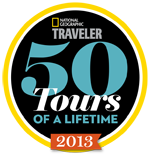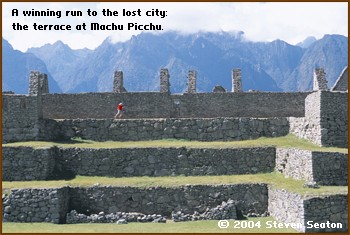
"Empire of the Run"
Story & Photos By Steven Seaton.
Adventure References: Chasqui Challenge 100 Mile Adventure Run & Stage Race & Inca Trail Marathon to Machu Picchu
Published in the October 2003 issue of Runner's World®. (Copyright 2003 Runner's World. Reprinted with permission.)
My head is throbbing, my hands are swollen and my lungs are so desperate for breath I could believe that only my right nostril is having success sucking in air. It’s tough going, but I’ve found my rhythm: two steps, stop, curse, bend forwards and wheeze like an old man, start moving again.
I know what you’re thinking. This is normal at this altitude.
Yesterday I was in Lima, the modern capital of Peru, looking out over the Pacific Ocean. Today I’m in Cusco, the capital of the once-powerful Inca Empire, which sits on a mountain plateau some 11,000ft higher. Elite athletes searching for serious altitude training never come this high and the idea of racing, never mind running a marathon, would be laughable. So what more could I expect?
Well, for a start I could expect that a hotel of this quality would have a lift to the dining room – the stairs are murder. The Inca Trail Marathon, my immediate goal, is still three days away. I’m exhausted, and I haven’t run a step yet.
I’ve been to altitude before, much higher altitude than this. I’ve even run marathons at this height as well. But I’ve never before been dropped in at 11,000ft only an hour after being at sea level and I wouldn’t ordinarily recommend it.
In this case, I could not recommend it enough. It’s a shock to your body, but it will cope, and the compensation that follows this relatively minor discomfort is an extraordinary running holiday.
I am in Peru’s southern Andes to do the Chasqui Challenge, a 100-mile adventure run and stage race put on by Andes Adventures, a small California-based operation that organises a series of running and trekking holidays throughout Peru and southern Patagonia.
Named after the running messengers used by the Inca kings to carry news to far corners of their empire, the Challenge is effectively two different and disparate trips that run as one. The first is as much a classic tourist holiday as a running one; an eight-day, five-star, whistle-stop guided tour of the region’s Inca and pre-Inca archeological sites, where optional daily training runs culminate in a race along the Inca Trail to Machu Picchu. The second (see above) is a more traditional wilderness running trip, moving on foot from campsite to campsite along rough trails that circumnavigate the base of the towering Ausangate massif in the Cordillera Vilcanota.
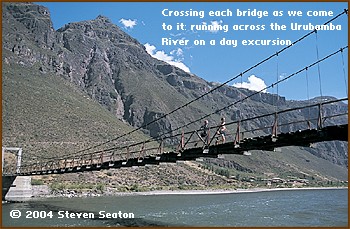 There are 15 men and 12 women signed up for the Challenge, the majority Americans but with a sizeable enough British minority to make it, if not an international trip, then at least a transatlantic one. Most of those intending to run (the group includes one walker and two non-running partners) have completed marathons or ultras before, two are there to tick off the South American leg of a seven marathons, seven continents challenge, but at least one is planning to run the Inca Trail with nothing more than a couple of 10K races under her belt. I’ll come back to her later. There are 15 men and 12 women signed up for the Challenge, the majority Americans but with a sizeable enough British minority to make it, if not an international trip, then at least a transatlantic one. Most of those intending to run (the group includes one walker and two non-running partners) have completed marathons or ultras before, two are there to tick off the South American leg of a seven marathons, seven continents challenge, but at least one is planning to run the Inca Trail with nothing more than a couple of 10K races under her belt. I’ll come back to her later.
The day after summiting my hotel stairway, I have my first run in Peru. It’s a gentle downhill shuffle through a dusty mountain valley, which passes the impressive white pools of the Maras salt mine. It’s a welcome break from a hard day of sightseeing. My head is well past its daily limit of Inca history and culture and I am still a bit disappointed that the Temple of Saccsayhuaman (which our guide keeps pronouncing as Sexy Woman) is a set of huge granite terraces looking out over Cusco.
Although it still feels like I am moving with a small person pushing down on my chest, it’s a much smaller person than the one I was carrying the day before. It’s surprising how quickly your body adapts. Well, not to everything. My body clock is still out of sync with the time zone, and although June – when the event took place – is the start of the Peruvian winter, there isn’t a cloud in the sky and it’s desperately hot, a common theme for the days ahead.
Devy Reinstein, a Peruvian-born American who organises and leads the tour, can’t do anything about the altitude, but he has a solution for the heat and the jet lag. Other than his endless supply of bottled water, he suggests that some of us might like to start the Inca Trail Marathon at 4.30am, an hour and a half before the sun comes up.
Well, that’s not quite his explanation for the early start, although it’s the one I’ve given to my wife, who happens to be that novice 10K runner who will be attempting her first marathon (and ultra, since the marathon is nearer 28 than 26 miles) at altitude in scorching heat. The alternate explanation is that since it takes most people four days to hike a trail we’ll be running in one, and as the last gate before Machu Picchu closes at 3pm, the early start is insurance for those who think they might have problems finishing the course on schedule.
We have moved on now from the luxury of a new five-star hotel every day – you wouldn’t believe how many they have in the most anonymous places in Peru – plus fine dining and air-conditioned coaches, to our first day’s camping in preparation for the start of the marathon. But the campsite close to the Urubamba River within the sacred valley of the Incas is not exactly hardship. This isn’t the ‘hump everything on your back’ camping that I remember from my youth. This is the ‘excuse me Sir, could I get you some more red wine’ camping that caters for today’s active, affluent, middle-aged market. You have to wash your own feet and do your own sleeping, but pretty much everything else is done for you. Someone carries your bags, puts up your tent, cooks your meals, waits on you in the dining tent and wakes you in the morning with hot coffee or tea.
The embarrassing size of the support staff required to keep our group pampered and happy only becomes apparent when we all turn out of our tents for the first ‘shoe and T-shirt’ ceremony. As well as being a hands-on, multi-role tour leader who joins in on all the runs, Reinstein is one of those good guys who clearly puts far more into his trips than he takes out. No detail, from the hand sanitiser he insists we use before every meal, to the horses he rustles up early one morning so that we can cross an icy stream without getting our feet wet, is too small to warrant his personal attention.
One of the notes in his extensive pre-departure instructions was a suggestion that we bring our old running shoes and T-shirts with us to Peru. Some of those are now laid out on the grass in neat little piles with a large pack of poncho-clad porters waiting in anticipation behind them. As well as paying a good daily rate and a handsome tip, Reinstein also wants each of our porters (as well as the cooks, kitchen help, guides, horse-handlers and aid station staff) to go home with at least one pair of shoes and a T-shirt. Since most are shod in nothing more than DIY rubber sandals hewn from old car tyres, a pair of over-sized, well-worn Nikes is quite a catch. It is nevertheless surreal, if satisfying, to pitch up at a mountain side aid station the next day to be met with a warm smile from a man wearing your Blackpool Marathon T-shirt.
Earlier in the morning, when the Inca Trail Marathon starts, I wouldn’t have noticed him. When you live in a city, you forget quite how dark, dark can be in the mountains. Even with a star-packed sky, a near full moon and my head torch on full beam, I can just barely see the shadowy figures ahead of me. The 3.30am wake-up call is surprisingly popular, with almost a dozen runners tucking into their quinoa (a high-protein cousin of oatmeal) porridge and pancakes before the off. Fortunately, the early trail is well defined, easy to follow and gently uphill. Reinstein assures us that even in the dark, there are few opportunities to get lost, but to be sure, he puts a guide at the front of the early group and another sweeping behind at the back. He obviously knows I could get lost on a one-way street.
After six miles we leave behind the last evidence of human existence, a scattered group of mud huts with a few farm animals wandering around in the darkness. As the trail turns sharply up towards the sky, our steady early progress turns to a laborious, hands-on-thighs slog.
This is the only run on the trip where we are wearing numbers, and the only one with timing, but not many of us are treating it like a normal race. Most are carrying cameras and intend to stop regularly en route to enjoy the spectacular views and visit some of the ruins beside the trail. To come here only to run would be criminal.
The record on the Inca Trail, set by a local porter, is 3:23. None of the runners on Reinstein’s trips have broken five hours, and he reckons seven is a good effort.
The steep climb up to the first major pass at 13,779ft (camp was at 8400ft) is unbelievably slow and painful. The pass, Warmiwanusq’a, means ‘pass of the dead woman’ in the local Quechua language, which seems awfully appropriate because that’s what I have beside me as we climb over it. Of course, it didn’t help that I took an unexpected detour in the dark, which cost us an hour and 500 extra feet of climbing, but we are already behind my most pessimistic schedule.
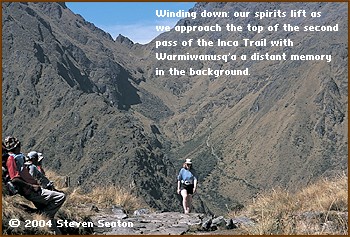 In the past couple of hours all the rest of the field has passed us and we’ve been through every emotion you would normally expect in the last six miles of a regular marathon, even though we are less than halfway in. I’ve been through my full repertoire of tricks – flattery, bribery, anger and disappointment – to keep my wife from stopping. Only the realisation that going back or stopping is no more attractive than going on has kept us going forward. In the past couple of hours all the rest of the field has passed us and we’ve been through every emotion you would normally expect in the last six miles of a regular marathon, even though we are less than halfway in. I’ve been through my full repertoire of tricks – flattery, bribery, anger and disappointment – to keep my wife from stopping. Only the realisation that going back or stopping is no more attractive than going on has kept us going forward.
Our spirits rise as we take the steep downhill path towards the Pacaymayo River and the first aid station, where Gatorade, water, bananas, chocolate and cold, salty potatoes await our arrival. The prevailing direction is now down, and with the altitude dropping we seem to be getting stronger and faster as the race progresses.
From the aid station the route follows the same pattern albeit in less extreme form: up to a steep hill, down again, up a more gentle climb and then down all the way to the most amazing finish any marathon could have. Along the way we pass by the ruins of the Runkurakau watchtower; stop off at the fortress of Sayacmarca that looks like something out of an Indiana Jones movie and descend thousands of stone steps.
Despite their skill with unfeasibly large granite blocks, the Incas were not good at planning efficient routes up and down mountains. They didn’t do switchbacks, just straight up or down. If the ground was too steep, which it was just about everywhere, they slapped in a stone staircase. So the route down from the barren high mountain passes, through the lush green cloud forest and into the jungle which surrounds Machu Picchu is largely on the biggest staircase in the world.
As the Peruvian government now limits access to both the Inca Trail and the ruins at Machu Picchu, there are few people on the trail with us. Those we do see are either hikers or porters. The hikers, who cover the course in four days, think we are crazy but are impressed; the porters, some of whom are running with 50 and 60lb loads, also think we are crazy but are harder to impress.
What will impress you, no matter how many photographs you have seen of it before, is Machu Picchu itself, sitting in the middle of the jungle on top of a mountain at the end of the Inca Trail. Although Francisco Pizzaro and the Spaniards, who followed his arrival in the 16th century, found and plundered anything of value in the Inca Empire, they never discovered Machu Picchu. Our struggle to arrive there in part explains why.
Three miles of jungle trails, which hug the mountainside and twist through a steep river valley, immediately precede it. At every turn you expect Machu Picchu to come into sight but it always seems to be around another corner. By now we are running as fast as we have in the whole race, the anticipation and excitement is almost unbearable.
Finally we climb some steps up to Intipunku, the Gateway of the Sun, and the city appears on its mountaintop-hiding place. It’s flanked on one side by the fast-running Vilcabamba River and on the other by steep mountains painted green by the lush jungle foliage. The jungle also skirts the bottom terraces of the city, and were it not constantly cut back, it would grow over the ruins again in a matter of months.
After close to 10 hours of hiking uphill and running down, the excitement of seeing the city is tinged with relief that the marathon is almost over. All the other British runners, one or two of the local guides and a couple of grazing llama are waiting at the finish line to greet us on the city’s otherwise deserted stone terraces.
I’ve been to many of the world’s great tourist attractions – the Taj Mahal, Coliseum, Pyramids, the Great Wall. Most, swamped with tourists, are disappointing. Machu Picchu is not. I imagine in part that’s because we arrived on foot, the way the Chasqui would have done centuries before us, but even had I taken the 30-minute ride up the mountain by bus, the remoteness and splendour of the location would have impressed.
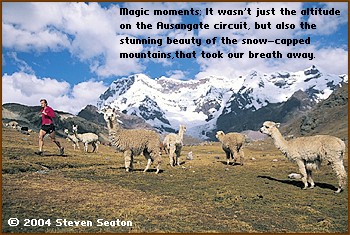 The trip is far from over after arriving at the lost city. Those of us moving on to the Ausangate circuit have another week of tough but spectacular running ahead of us. Even the ones leaving Peru after the first week still have a day to enjoy exploring and hiking around the ruins of Machu Picchu, an incredible ride back towards Cusco in a glass-topped train, more running in the Urubamba valley, visits to archeological sites and local markets, and a day in Lima for a quick tour of its Spanish colonial past. The trip is far from over after arriving at the lost city. Those of us moving on to the Ausangate circuit have another week of tough but spectacular running ahead of us. Even the ones leaving Peru after the first week still have a day to enjoy exploring and hiking around the ruins of Machu Picchu, an incredible ride back towards Cusco in a glass-topped train, more running in the Urubamba valley, visits to archeological sites and local markets, and a day in Lima for a quick tour of its Spanish colonial past.
Although the Inca Trail Marathon remains its high point, this is still a running holiday where the emphasis is on the holiday rather than the running. It has become a cliché to talk of every trip as the holiday of a lifetime. But for someone with an interest in history, culture and geography, this chance to knit it all together with running in the company of an excellent group of like-minded people, is as good as it gets.
Steven Seaton is the Editor of Runner's World (UK).
|
